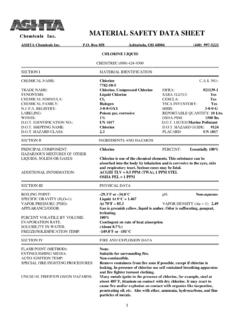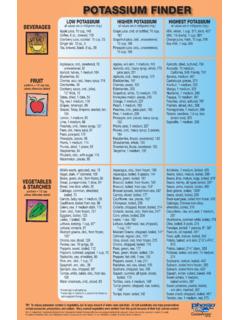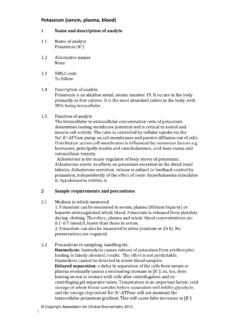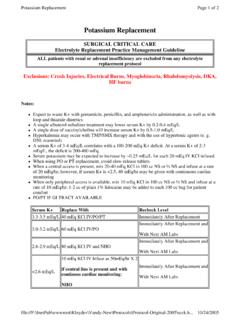Transcription of MATERIAL SAFETY DATA SHEET - Potassium …
1 MATERIAL SAFETY DATA SHEET . ASHTA Chemicals Inc. Box 858 Ashtabula, OH 44005 (440) 997-5221. CAUSTIC POTASH LIQUID. CHEMTREC: (800) 424-9300.. SECTION I MATERIAL IDENTIFICATION.. CHEMICAL NAME: Potassium hydroxide , Solution NO.: 1310-58-3. TRADE NAME: Potash, Potash Liquor WHMIS: 1%. SYNONYMS: Caustic Potash Liquid, Potassium Hydrate, Lye, KOH. CHEMICAL FORMULA: KOH (45% to 52% aqueous) CERCLA: Yes CHEMICAL FAMILY: Alkali TSCA INVENTORY: Yes REGISTRY: 3-0-1 SARA III: Yes LABELING: Corrosive REPORTABLE QUANTITY: 1000 Lbs PACKING GROUP: II. IDENTIFICATION NO.: UN 1814 HAZARD GUIDE: #154. SHIPPING NAME: Potassium hydroxide Solution or Caustic Potash Solution HAZARD CLASS: 8 PLACARD: UN 1814.
2 SECTION II INGREDIENTS AND HAZARDS.. PRINCIPAL COMPONENT: KOH PERCENT: 45-52% Remainder is water HAZARDOUS MIXTURES OF OTHER (see SECTION X). LIQUIDS, SOLIDS OR GASES: This MATERIAL reacts violently with acids. Reacts with aluminum, tin, zinc and generates flammable hydrogen gas. ADDITIONAL INFORMATION: ACGIH TLV = ( C ) 2mg/m3. OSHA PEL = None . SECTION III PHYSICAL DATA.. BOILING POINT: 45% = 270 F. 50% = 292 F. SPECIFIC GRAVITY (H2O=1): At 20 C 45% = At 20 C 50% = VAPOR PRESSURE (mm Hg): At 20 C (68 F) = 2 mm pH: >14. VAPOR DENSITY (AIR = 1): N/A MOLECULAR WEIGHT: APPEARANCE/ODOR: Colorless, viscous liquid. No odor. PERCENT VOLATILE BY VOLUME: Approximately 50%.
3 EVAPORATION RATE: Slightly less than water. SOLUBILITY IN WATER: Complete. FREEZE/SOLIDIFICATION TEMPERATURE: 45% = -20 F. 50% = 48 F.. SECTION IV FIRE AND EXPLOSION DATE.. FLASH POINT (METHOD): None. EXTINGUISHING MEDIA: Suitable for surrounding fire. AUTO IGNITION TEMP: Non-combustible. SPECIAL FIRE FIGHTING PROCEDURES: Wear clothing and equipment to avoid body contact.. SECTION IV FIRE AND EXPLOSION DATE, cont'd.. UNUSUAL FIRE/EXPLOSION HAZARDS: This MATERIAL is corrosive to all human tissue. It will react violently with many organic chemicals, especially nitrocarbons and chlorocarbons. Caustic potash reacts with zinc, aluminum, tin, and other active metals liberating flammable hydrogen gas.
4 Dilution with water evolves large amounts of heat.. SECTION V HEALTH HAZARD DATA.. OSHA PERMISSIBLE EXPOSURE LIMIT: None ACGIH THRESHOLD LIMIT VALUE: ( C ) 2mg/m3. IARC/NTP CARCINOGEN: Not listed MUTAGENIC: Not listed TERATOGENIC : Not listed REPRODUCTIVE TOXICITY: Not listed PRIMARY ROUTE(S) OF EXPOSURE: Body contact. TARGET ORGANS: All human tissue damaged on contact. EFFECTS OF EXPOSURE: INHALATION: Mist may cause injury to entire respiratory tract. SKIN: Contact with concentrated solutions may cause serious burns to human tissue. EYES: Will cause severe to permanent injury. INGESTION: Damages throat area and gastro-respiratory tract. EMERGENCY FIRST AID: INHALATION: Remove from exposure.
5 Get medical help. SKIN: Remove contaminated clothing and thoroughly water flush with tempered water on the affected areas. EYES: Flush with water for at least 15 minutes with tempered water. INGESTION: Drink plenty of water or fruit juice. Do not induce vomiting. Get prompt medical help.. SECTION VI REACTIVITY DATA.. STABILITY: Stable under normal conditions. CONDITIONS TO AVOID: Do not allow contact with acids and metals such as aluminum, zinc and tin. INCOMPATIBILITY: (MATERIALS TO AVOID): Organic chemicals, nitrocarbons, halocarbons, and metals or alloys mentioned above. HAZARDOUS DECOMPOSITION PRODUCTS: Flammable hydrogen gas may be generated when KOH and certain metals react.
6 POLYMERIZATION: Will not polymerize. CONDITIONS TO AVOID: Exposure to air can form Potassium carbonate. ADDITIONAL INFORMATION: Trichlorethylene will react to form Dichloracetylene, which is spontaneously flammable.. SECTION VII ENVIRONMENTAL PROTECTION PROCEDURES.. SPILL RESPONSE: Protective clothing and equipment must be worn by clean-up personnel. Contain spillage or leakage in suitable container or contain in a holding area. Do not allow drainage to sewers, streams or storm conduits. Recover with vacuum equipment such as a septic tank truck or neutralize with weak acid solutions and flush with water. Avoid splashing or misting which could increase health hazards.
7 WASTE DISPOSAL METHODS: Dispose of spillage waste per company contingency plan and in accordance with federal, state, and local regulations. Neutralized waste is composed of salt and water. ADDITIONAL INFORMATION: Reportable spillage quantity is 1000 lbs., or 454 kg. Planning ahead is essential for handling spills. Proper equipment and trained employees should be readily available to correct a spill situation. 2.. SECTION VIII SPECIAL PROTECTION INFORMATION.. EYE PROTECTION: Chemical splash goggles and face shield. RESPIRATORY PROTECTION: None is normally required, however, if misting or heavy vapor formation should occur, a NIOSH approved mist respirator should be worn.
8 SKIN PROTECTION: Rubber or plastic - impervious and/or waterproof. OTHER PROTECTION: Rubber boots. Rubbers over leather shoes are not recommended. Rubber apron, rainwear or disposal tyvek suit with hard hat should be worn. VENTILATION RECOMMENDED: Provide adequate ventilation to meet TLV requirements. GLOVE TYPE RECOMMENDED: Rubber, nitrile, neoprene, PVL. ADDITIONAL INFORMATION: SAFETY eyewash/shower stations must be available in the work area.. SECTION IX SPECIAL PRECAUTIONS.. HYGIENIC PRACTICES IN. HANDLING/STORING: Avoid body contact. Immediately flush contact area with water. PRECAUTIONS TO BE TAKEN FOR. HANDLING/STORING: Storage tanks should be contained in a diked area that has sufficient capacity to hold the contents of the tank.
9 This area should be free of potential contact with acids, organics, and reactive metals. PRECAUTIONS FOR. REPAIR/ MAINTENANCE. OF CONTAMINATED EQUIPMENT: Wash thoroughly with water. OTHER PRECAUTIONS: Spillage can be slippery.. SECTION X TRANSPORTATION.. USUAL SHIPPING CONTAINERS: Tank car, Tank truck, ABS Drums. USUAL SHELF LIFE: Sealed containers, unlimited. STORAGE/TRANSPORT TEMPERATURES: Above 60 F, below 120 F. SUITABLE STORAGE. MATERIALS/COATINGS: Steel, plastic, PE (when dry). UNSUITABLE: Aluminum or galvanized containers. OTHER INFORMATION: 1) Keep containers sealed to avoid absorption of moisture. 2) 45% to 52% is the most commonly sold concentration range of Caustic Potash Liquid.
10 ASHTA Chemicals Inc. does provide other concentrations to those customers requesting such. The hazard information for the other concentrations remains accurate, but the physical data will vary. Should you need specific physical data for a concentration not described on this MSDS, please contact ASHTA Chemicals Inc. REVIEWED: 4/09 (No changes made). SUPERSEDES: 03/06 (No changes made). 05/03 (Added WHMIS percentage). THIS INFORMATION IS DRAWN FROM RECOGNIZED SOURCES BELIEVED TO BE RELIABLE. ASHTA Chemicals Inc. MAKES NO GUARANTEES OR ASSUMES ANY LIABILITY IN CONNECTION WITH THIS INFORMATION. THE USER. SHOULD BE AWARE OF CHANGING TECHNOLOGY, RESEARCH, REGULATIONS AND ANALYTICAL PROCEDURES.








